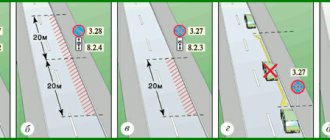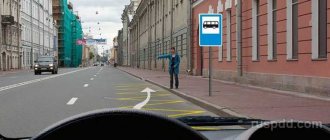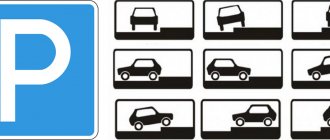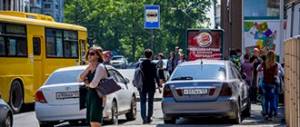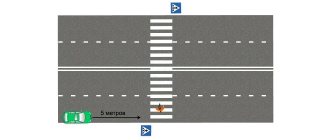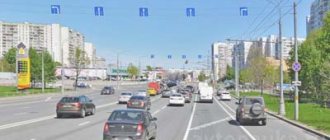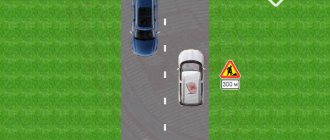Why are parking lot signs needed?
Gaps in legislation regarding the designation of parking spaces have caused all sorts of controversial situations. Paid parking, organized, in fact, illegally, has become increasingly popular. Sometimes rent for a car parked in the courtyard of an apartment building was forcibly collected from the residents of the apartments located in these buildings.
In order to suppress illegally issued parking fines, the term “parking” was established in the traffic rules. To indicate the parking lot, road sign 6.4 was identified, which previously designated a parking space. This step gave rise to new controversial situations, because the parking areas previously designated with such a sign did not correspond to the new definition of parking.
To eliminate the incidents that arose, clause 12.2 of the traffic rules was changed, the new edition of which reflected the possibility of parking a car as follows:
- parallel to the roadway:
- at an angle to the road if there is a sign indicating this type of parking.
Inaccuracies in the legal acts regulating car parking rules gave rise to unauthorized actions on the part of traffic police officers. Thus, for parking in a pocket that is not parallel to the road, the driver was fined 500 rubles. according to Art. 12.19. To systematize legal acts, the term “platform” began to be used.
Car parking dimensions
The vast majority of car owners every day are faced with clogged entrances and exits from yards, the inability to park next to a store or institution, any trip around the city requires a place where you can park your car for a while.
In modern cities, special areas for parking vehicles are set up for this purpose - parking lots or parking lots; multi-level parking lots are often built.
Kinds
There are several ways to arrange parking spaces, each with its own pros and cons.
The most common include:
- parallel to the edge of the road;
- perpendicular (at an angle of 90 degrees);
- herringbone (at an angle of 45 degrees).
Let's take a closer look at these types of parking:
- Parking space at 45 degrees. The marking is made at an angle of 45 degrees to the roadway. This type of parking is convenient to use; the driveways between the rows of cars can be made a little narrower than usual, since leaving the parking space at a smooth angle is much more convenient and the car requires less space to maneuver. Photo 1. Parking lot markings at an angle of 45 degrees: Markings not at right angles to the driveway simplify vehicle maneuvers when entering/exiting, entering and leaving the parking lot becomes more convenient and faster, and the likelihood of traffic jams is reduced.
- Parking space at a 90 degree angle. Such parking spaces require great skill from the driver, since parking the car and leaving the parking lot is much more difficult than with an oblique angle; more space is needed for maneuver. Photo 2. Marking the parking lot at an angle of 90 degrees (perpendicular to the driveway): Placing vehicles at right angles to the roadway, which is organized in the form of a narrow strip in front of the building, creates a danger for both passing vehicles and cars leaving the parking lot, so how they get straight from the parking space onto the roadway. At the same time, the capacity of such perpendicular parking is greater than any other.
- Parallel arrangement. Most often, such parking spaces are found along the roadway near sidewalks. If cars are located close to each other, then parking or leaving the parking lot is quite difficult. Photo 3. Parallel parking: So, for example, when marking a parking lot at an angle of 45 degrees, the required area for one car space is almost one and a half times larger than when marking transversely, and the occupancy rate of cars on a hundred-meter strip is almost thirty percent lower.
Any parking lot must provide the ability to easily enter a parking space, therefore, for example, if there is a narrow passage between the markings, then it makes sense to increase its length.
Table. Lanes for parking cars.
| Placing cars at an angle to the roadway | 45° | 60° | 90° |
| Width, m | 5 | 5,4 | 5,5 |
| Required area, sq.m. per vehicle | 18 | 16 | 13 |
| Number of cars that can fit on a 100 m long lane | 31 | 38 | 43 |
Regulatory requirements for parking space size
In accordance with Order of the Ministry of Economic Development of the Russian Federation dated December 7, 2021 No. 792 “On establishing...”, the minimum (5.3 x 2.5 meters) and maximum (6.2 x 3.5 meters) dimensions of one parking space are established.
Parallel parking size
Parallel parking lots are installed in places where it is not possible to move the parking lot further from the road than two to three meters. At the same time, the width of the parking space may be minimal, sufficient only to park a passenger car.
However, if such parking spaces are located between traffic lanes, they must be widened for the safety of people exiting the vehicle.
A standard car is 4.4 meters long and 1.8 meters wide.
For parallel parking, the dimensions of the area in meters for 2019 should be at least twice the length of a regular passenger car; this will allow, with minimal skill, to drive between two other parked cars without much risk of hitting them.
The width of such a parking lot should be equal to the width of a regular car, plus one meter to ensure the safety of both the vehicle itself and the driver, as well as passengers getting out or getting into the car.
Perpendicular
Perpendicular placement of parking spaces is suitable for those parking lots whose width will allow you to freely enter and exit the parking lot without interfering with the movement of vehicles on the roadway. This placement of cars saves space, but makes it difficult for vehicles to enter and exit.
More suitable for small-sized “pockets” on the roadway with a width of five meters or more. One parking space will require only about thirteen square meters, since the width of one parking space may be minimal.
Herringbone
Diagonal herringbone parking markings are more suitable for large parking lots and parking lots; cars are located in dense rows parallel to each other at an indirect angle to the driveway with a zigzag line between the cars.
The top view of this arrangement resembles a Christmas tree, which is why this arrangement is called a “herringbone”. The location of the cars at an angle of 45 degrees implies the size of one parking space of 18 square meters, and the length of one parking space does not exceed five meters.
For invalids
Parking spaces for disabled people require an increase in parking space, this is due to the fact that such vehicles are often driven by wheelchair drivers, and there are also quite a lot of such people among the passengers.
Therefore, the width of the parking space should allow not only the driver and passengers to get out of the car, but also to unload the wheelchair so that it can easily fit between two cars. Photo 4.
An example of a parking location for disabled people: It is recommended to place parking spaces for people with disabilities close to the entrance to the parking lot; on the one hand, this will save space, and on the other hand, it will allow people with disabilities to park closer to the exit for ease of movement.
Typically, parking spaces for the disabled are located within fifty meters of institutions (clinics, social services and other institutions where there is a high likelihood of persons with disabilities).
Such places are marked with special road signs; usually 10-20% of all parking spaces are allocated for them. The width of a parking space for disabled people must be at least three and a half meters for the convenience of passengers and drivers.
For trucks
The practice of organizing parking lots and parking lots shows that it is not practical to allocate space for heavy trucks in the parking lot of passenger cars. Photo 5. Example of truck parking location:
Typically, separate parking lots are equipped for them, taking into account the following conditions:
- the possibility of through passage through the entire parking lot must be created;
- It is necessary to apply markings that allow reversing;
- the arrangement of distances between rows should be as wide as possible so that nothing prevents heavy and bulky cars from turning into or out of a parking space.
Basic rules and types of markup
Among the basic rules for applying markings in parking lots, the following should be highlighted:
- Be sure to take into account the dimensions of vehicles of any brand.
- A person must move freely between two cars from adjacent rows standing with open doors.
- It is necessary to keep in mind that not all drivers are experts in their field, there are many newcomers behind the wheel, not everyone knows how to park correctly, so when applying markings you need to take this factor into account as well as the need to maneuver when entering and leaving the parking lot.
In addition to the basic rules, there are also so-called minor ones, which also need to be taken into account when arranging parking:
- The thickness of the marking lines should be clearly visible both during the day and at night; in recent years, more and more parking lots have been marked with paint with a reflective effect.
- Fences, bollards, columns and other elements must not interfere with vehicles and in no case should they reduce the minimum size of a parking space.
- The markings must be applied in strict accordance with the standards.
What documents reflect the basic concepts?
To determine whether a driver has violated the Traffic Rules in terms of illegal parking or to protect his interests in court, it is necessary to have an understanding of the basic concepts of parts of highways.
The following documents will help you get acquainted with the concepts:
- Traffic rules in which only “parking” is used among the terms for organizing parking, i.e. a specially designated area intended for paid or free (depending on the owner’s decision) car parking.
- GOST 32846-2014, reflecting the improvement of public roads. According to this document, a parking lot can include not only an organized site, but also an expansion of the roadway intended for:
- transport stops;
- short-term parking at monuments, service stations or other objects.
- GOST R 52289-2019. According to this document, car parking is designated using the sign 8.6.1 “Method of parking.” The presence of a sign indicating the specific method of positioning the vehicle under the sign is mandatory.
Clause 5.7.5 of the specified GOST excludes the designation of parking without such signs. Thus, a sign indicating parking and not having an additional sign indicating the method of parking (8.6.2 - 8.6.9) will be recognized as not complying with the GOST in question. Prosecution for illegal parking on the basis of such a sign will be unlawful and easily contested in court.
- SP 42.13330.2016 – set of rules for urban planning. This document reflects the concept of parking as follows: a site on the roadway or sidewalk, provided with the necessary capacity (number of cars per hour).
- SP 396.1325800.2018 - a set of rules for streets and roads running in populated areas, reflecting, among other things, the width of parking lots. According to this document:
- parking is not allowed on main roads and streets of 1st and 2nd class;
- it is allowed to organize parking on class 3 main streets and district streets in specially designated pockets;
- no restrictions are imposed on parking lots located on city or village streets. Thus, if the pocket is located on a section of a residential or town street, you can park your car without the risk of being held liable.
What is a pocket according to traffic rules and GOSTs?
When considering a complaint in an administrative case, it is necessary to consistently convince the judge or the head of the traffic police that the driver did not violate any rules. And you need to be prepared for questions from them. For example, why did you suddenly decide that widening the roadway is called a “pocket”? Or what is the correct name for organized parking along the edge of the roadway if there is no such widening?
And to understand all the intricacies, we need five documents:
- Traffic rules - here we can understand whether the term "pocket" is even used as part of the road,
- GOST 32846-2014 – Arrangement elements. Classification,
- GOST R 52289-2019 – Rules for the use of signs, markings and other road elements,
- SP 42.13330.2016 – Urban planning. Planning and development of urban and rural settlements,
- SP 396.1325800.2018 – Streets and roads of populated areas, and here we can find the width, length or depth of parking lots.
Let's start with semi-legal paid parking lots, of which there have been too many in the recent past. Even in their own yard, citizens were forced to pay for parking so they could sleep peacefully. Those who disobeyed had their tires punctured and their windows broken.
The first step in establishing order with the collection of parking fees was the introduction into the legislation, including the traffic rules, of the very term “Parking”, according to which only the owner could decide whether to charge for parking or not. Subsequently, even sign 6.4 “Parking Place” was renamed “Parking”. And confusion began, because not every parking space is a parking lot in its classical sense. If we return to the yard parking lot, it is not such. The law only allows its organization in a given territory.
You will also be interested in:
- Bus lane according to traffic rules and fines for driving and stopping on it in questions and answers
- Road sign “Parking prohibited” according to traffic regulations: what is the coverage area, where and who can park?
- What is the fine for parking and driving on the sidewalk? Appeal and subtleties of traffic rules
The consequence of the poorly thought-out experiment was the emergence of a new version of clause 12.2 of the traffic rules, according to which cars are allowed to be parked only along the road, and only, as an exception, at an angle to the edge of the roadway, when a parking sign is installed with the corresponding sign “Method of parking.” It is specified:
...if the configuration (local widening) of the roadway allows such an arrangement.
At the time of the change to 12.2 of the traffic rules, the regulatory framework for organizing parking spaces in pockets was weak, which led to arbitrariness on the part of traffic police inspectors: standing in a pocket not parallel to the edge of the roadway - receive a fine of 500 rubles under Part 1 of Article 12.19 of the Administrative Code.
To eliminate ambiguity in regulatory documentation, the term “site” began to be actively used. It is through it that all parking spaces, including parking lots, are designated. Let's open GOST 32846-2014. As you can see, among the parking spots there are:
- parking,
- observation deck,
- recreation area,
- parking lot (not to be confused with parking).
But the most important thing is this!
Parking area for vehicles - an equipped area or widening of the roadway for stopping and short-term parking of cars at road service facilities, historical and architectural complexes and other places attractive to road users with systematic stopping of cars
As you can see, by definition, this site is not a parking lot, but it can be located on a widened roadway, as stated in paragraph 12.2 of the Rules.
But how to designate all the listed sites as parking areas? After all, sign 6.4 can only mean parking! Nothing like this. The new GOST R 52289-2019 states that with signs “Method of parking” the sign can indicate any site. Moreover, the main change is that a sign under the sign is now required.
If you carefully read the corresponding paragraph 5.7.5 in this GOST, you will see that a parking sign without any signs is never installed anywhere. If you see a single sign 6.4, then its installation does not comply with the requirements of this GOST.
But in these documents the pocket is not mentioned. It’s okay, let’s turn to the Code of Rules (SP), according to which cities, city highways and streets are built.
Let’s open SP 42.13330.2016 and immediately see that the term “parking” has an independent meaning:
A parking lot (open area) for public use, arranged on elements of the transverse profile of the road network (roadway, sidewalk), with entry and exit only from the carriageway of the street (road), arranged subject to ensuring the throughput of the roadway and sidewalks .
A pocket is a special case of parking. This is part of the road, since it is located on the roadway (its widening, if the pocket is intended for stopping or short-term parking - this is specified in GOST 32846-2014) or on the sidewalk.
According to SP 42.13330.2016, all roads in the city are divided into:
- main roads of 1st and 2nd class;
- main streets of 1st, 2nd and 3rd classes;
- district streets;
- local streets.
The development of SP 42.13330.2016 is SP 396.1325800.2018. According to this document:
- on main roads and main streets of 1st and 2nd class, parking is unacceptable;
- On class 3 main streets and district streets, parking is permitted only in pockets if it is possible to arrange them;
- On local streets, parking is available without restrictions, including in pockets.
By the way, parking along the edge of the roadway is organized in the form of parking strips.
Can you park in your pocket?
Any pocket on the roadway must be marked with one of the following images:
- Yellow markings 1.17 together with signs indicating stopping places for route vehicles (5.16-5.18). Parking a car under such conditions is unacceptable;
- A “Parking” sign with a sign indicating the specific way to park the car. In such a place, the driver has all legal grounds for parking;
- "No Stopping" sign.
Sometimes, in front of a pocket that is not marked with a sign or markings, there is a 3.2 sign prohibiting stopping in the indicated place. This fact misleads drivers, because in fact the unmarked pocket is not part of the road covered by the sign. But traffic police officers often do not share this point of view and attribute the pocket to the widening of the roadway.
Many sources say that if, along with the “No Stopping” sign, a “Parking” sign is installed, then the latter will have priority. However, there are often cases in which traffic police officers draw up reports on drivers who parked a car in such a controversial place.
If the sign prohibiting stopping is also supported by the “Car Towing” sign, then in order to avoid disputes and fees for impound parking, the driver should look for a more suitable place to park the vehicle.
How to create parking in the yard
June 30, 2015
The yards are becoming increasingly crowded with cars. Awnings installed without rental agreements are being removed everywhere, and in the near future there will be no more of them left. But where to store cars for those who do not have enough money for a major garage?
With your option - to the council
Where there are suitable sites, open parking lots are organized. But this is not easy: there are few free places, not every site is suitable, and a lot of approvals are required. In addition, it often happens like this: if five “shells” are demolished in the yard, the space is freed up, but you can’t equip it with a parking lot for five cars! The places will turn out to be “golden”. What to do in this case? There is only one thing left: to equip guest parking pockets.
When landscaping the territory, they try to do this, using every suitable place. The problem is that budget funds are not enough to simultaneously satisfy the needs of motorists of all yards. As reported in the district department of transport and communications, it is possible to equip such parking lots at the expense of the residents themselves. To do this, it is necessary to create an initiative group of motorists in the yard.
Moreover, it is advisable to interview all residents: find out who wants to participate in the creation of a parking lot, whether there are those who object to it and why - then there will be fewer surprises later. Then the usual procedure is as follows: you need to come to your district government and write an application, attaching a diagram with your parking location option and lists of potential participants with their contact information.
The council will tell you how realistic the proposed option is and what to do next: where to apply, what approvals need to be completed (in any case, the procedure is much simpler than with organizing an open parking lot). They may also suggest an organization capable of performing all the necessary work. However, car owners have the right to choose it themselves, especially since the cost of the work will depend on this.
The administration will only make sure that the yard is not damaged (trees are not cut down, lawns and playgrounds are not taken over).
Is the lawn trampled? Do eco-parking
Lawns have their own challenges. As a rule, there is nowhere else to create additional parking pockets: all the courtyard driveways are already crowded with cars. But even if the lawn, as experts say, is “depressed” (that is, long ago turned into a muddy mess by wheels), the Department of Natural Resources, as a rule, does not allow making an asphalt area in this place.
In this case, there is only one thing left to do: equip an eco-parking area - lay powerful lawn grates, in the cells of which grass will grow. Usually no one objects to this: neither residents nor authorities. But eco-parking has a drawback - its high cost (usually from 25-30 thousand rubles per parking space, and if there are few spaces, then more).
There is another problem: land relations when creating courtyard parking lots, unlike open parking lots, are not formalized, and by law the spaces remain common. Therefore, it is impossible to fence them with posts and chains - this will be regarded as self-capture. The actions of those who unauthorizedly occupy public land by constructing fences in parking lots fall under Article 6.
5 of the Code of Administrative Offenses of the City of Moscow (Moscow Law No. 45). According to this article, unauthorized restriction of access to public land plots entails the imposition of an administrative fine. For individuals, its size is from 500 to 1000 rubles. So anyone who has hung a chain or installed a blocker in their yard should not be surprised by the visit of the local police officer.
In addition, even if you are not “tracked down” and not fined, you will have to part with the chain in any case: unauthorized fences in parking lots are regularly dismantled by contractors servicing the yards.
Five people park – the whole house benefits
Would anyone want to invest a lot of money in landscaping their yard, knowing that any motorist can park in the place for which he paid for the equipment, and on completely legal grounds? It happens.
For example, as Tatyana Lalak, head of the construction and garage department of the Alekseevsky district administration, said, last year an eco-parking was installed near building 5 on Novoalekseevskaya Street. After a survey conducted by the initiative group among the residents of the building, most of them agreed to contribute their funds to the arrangement of the parking lot.
As a result, although it was not cheap (about 200 thousand rubles), the amount was not too large for each person. Although the parking lot can only accommodate 5-6 cars, it brought tangible benefits to all residents of the building. The fact is that the courtyard passage was expanded, removing at least some of the cars from it (before, driving to the house was problematic, including for ambulances).
So, if you have interesting ideas for placing cars in your own yard, you should contact the council for advice in any case: perhaps, in the end, an option will appear that suits everyone.
Alexander KARCHEVSKY
Source: https://ecoparkovka.ru/news/view/57
If the parking space is not marked in any way
According to traffic regulations, the road is intended for traffic, and the territory adjacent to it is intended for parking, in which, on the contrary, through traffic is prohibited. If the pocket is not marked in any way, it is considered the same as the territory adjacent to the road and allows parking of vehicles.
Clause 12 of the traffic rules indicates the possibility of parking:
- on the side of the road located to the right of the roadway;
- on the edge of the road;
- in exceptional cases on the sidewalk in specially designated places, subject to the presence of an appropriate sign and plate.
However, pocket parking still causes many controversial situations between drivers and inspectors. To prevent such disputes, the legislator should systematize the regulatory framework on the issue under consideration.
Installation of a parking pocket - Germany
It is believed that Germany has the best roads in the world. In the ranking, this country ranks first in Europe. This country has a widespread network of highways with no speed limits.
Historical facts speak for themselves. In Germany, autobahns began to be built 80 years ago. Most of the autobahns in Germany were built during the Third Reich. The military dictatorship of those years built roads taking into account the movement of tanks along them. Accordingly, the highways inherited from those distant times have been preserved in excellent condition. Road construction in Germany has always been at a high level.
The main “recipe” for excellent roads in Germany is a large base, several meters thick. Typically the base consists of numerous layers of building material. The construction team begins laying asphalt only after the base has been thoroughly prepared. Asphalt is laid in various fractions in several layers.
There is also legislation in the country that everyone follows. The company that built the road provides a guarantee upon completion of construction. If potholes appear on the road during operation, the company carries out repairs at its own expense. Any damage to a vehicle caused by an uneven road may lead to lawsuits from citizens of the country against the contractor company.
Responsibility
Punishment for a violation committed when parking a vehicle is regulated by Article 12.19 of the Administrative Code. Its size directly depends on the type of offense committed:
- Stopping at a widened roadway that is not marked accordingly will result in a fine of 500 rubles. The first time the driver gets off with a warning. If the violation occurs on the streets of St. Petersburg or Moscow, the fine will be 5 times greater (RUB 2,500).
- Parking on a section of road designated for stopping minibuses, buses or taxis will result in a fine of 1,000 rubles for the offender. In this case, residents of Moscow and St. Petersburg will have to pay 3,000 rubles.
If the driver believes that penalties were applied to him illegally, he can appeal the decision made by the traffic police officer. To do this, you need to prepare a sufficient evidence base and learn all the rules and concepts specified in the article.


